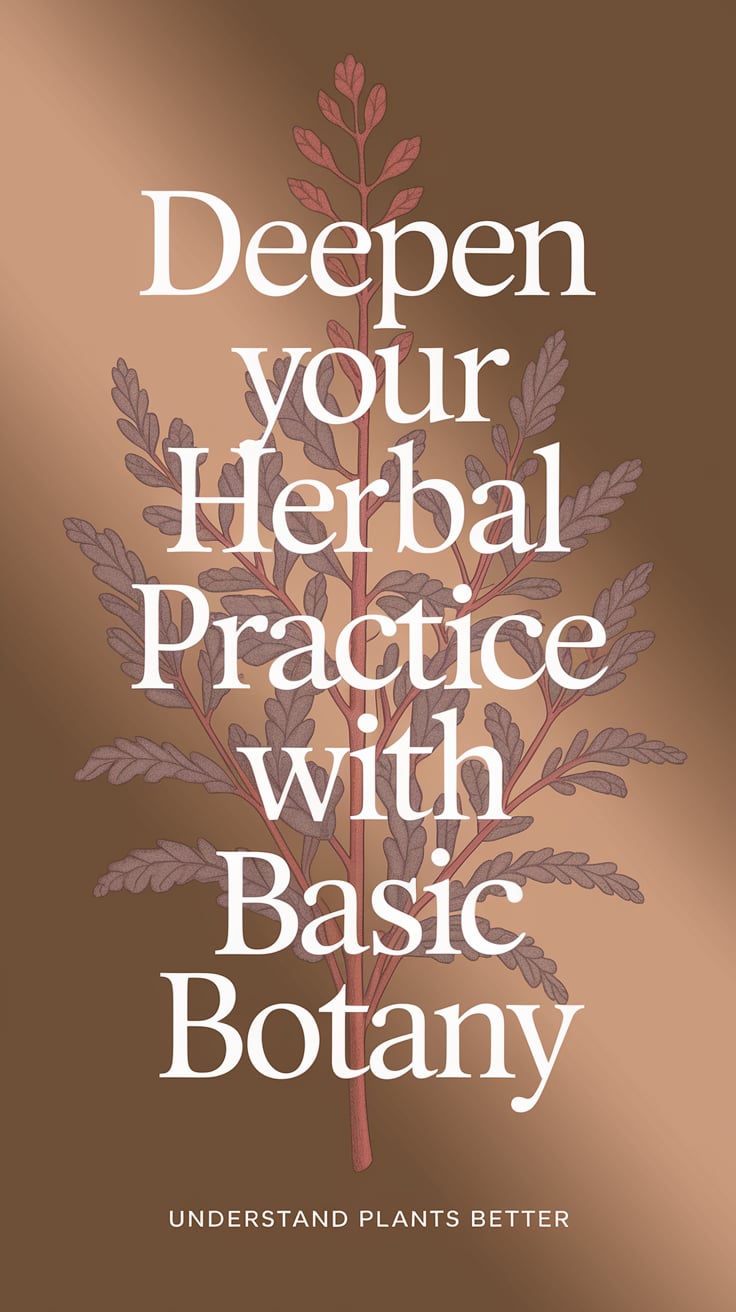Basic Botany for Witches: Plant Magic Fundamentals Every Practitioner Should Know
Please note that posts on this site may contain affiliate links
Have you ever wondered why some plants just feel magical while others seem ordinary? Or why certain herbs work better for protection spells while others excel at love magic? The answer lies in understanding the fundamental science behind plant magic – botany.
Many witches approach herbalism purely through correspondences and folklore, but combining this intuitive knowledge with basic botanical principles creates a deeper, more powerful practice. When you understand how plants actually work – their anatomy, life cycles, and natural processes – you can make more informed choices about which herbs to use and when.
Is botany hard to learn? Not at all! While professional botanists study for years, the fundamentals are surprisingly accessible when you approach them with curiosity rather than intimidation. You don’t need advanced mathematics or laboratory equipment to grasp the basics that will transform your magical practice.
This guide bridges the gap between scientific botany and magical herbalism, giving you the foundational knowledge to work with plants more effectively. Whether you’re just starting your journey as one of the many types of witches who work with plants or you’re looking to deepen your existing practice, understanding basic botany will elevate your magical work.
- Why Every Witch Needs Basic Plant Knowledge
- Plant Anatomy: Where Different Energies Live in Nature
- Understanding Plant Families for Stronger Magical Work
- Life Cycles and Seasonal Energy Patterns
- Photosynthesis: The Solar Magic Connection
- Root Systems and Grounding Magic
- Plant Reproduction and Fertility Magic
- Plant Defenses and Protection Magic
- Connecting Scientific Knowledge with Magical Intuition
- Practical Exercises for Magical Plant Observation
- Building Your Botanical Witch Practice
- Advanced Applications and Continuing Education
- Conclusion: Growing Your Magical Practice
Why Every Witch Needs Basic Plant Knowledge
The fundamentals of botany provide the foundation for all plant magic. When you understand how plants actually function, you can work with them as living allies rather than just magical ingredients. This knowledge helps you choose the right plant parts for specific spells, understand when to harvest for maximum potency, and recognize the subtle signs that indicate a plant’s magical readiness.
Traditional herbalism has always combined practical plant knowledge with spiritual understanding. Ancient healers and wise women weren’t just memorizing correspondences – they were keen observers of plant behavior, growth patterns, and seasonal changes. This observational approach forms the core of both botanical science and magical practice.
Many beginning practitioners worry about the complexity of plant science, but the basics are surprisingly straightforward. The five main branches of botany include plant anatomy, physiology, ecology, genetics, and evolution. For magical purposes, focusing on anatomy, physiology, and ecology provides the most practical foundation.
Understanding plant families also helps you identify new magical allies. When you know that plants in the mint family (Lamiaceae) often share similar properties, you can more confidently work with new herbs based on their botanical relationships. This knowledge becomes particularly valuable when you’re working with herbs that provide grounding and stability or exploring plants that enhance communication and mental clarity.
The key is approaching botany with the same curiosity and respect you bring to other magical studies. Learning foundational plant knowledge takes time, but the insights gained transform every aspect of your herbal practice.

Plant Anatomy: Where Different Energies Live in Nature
Every part of a plant serves a specific function, and understanding these functions helps you choose the right plant parts for your magical work. The anatomy of plants reveals where different types of energy concentrate, making your spells more targeted and effective.
Roots anchor plants to the earth and absorb nutrients from the soil. Magically, roots excel at grounding work, protection magic, and spells requiring deep, stable energy. They connect us to the earth element and ancestral wisdom. When working with root magic, you’re tapping into the plant’s foundational energy – its ability to draw strength from the earth itself.
Stems provide structure and transport nutrients throughout the plant. They represent communication, connection, and the flow of energy between earth and sky. Stem magic works well for spells involving communication, strengthening relationships, or connecting different aspects of your life. The hollow stems of plants like elderberry have traditionally been used for wind instruments and communication magic.
Leaves are the plant’s solar panels, converting sunlight into energy through photosynthesis. They hold active, dynamic energy perfect for spells requiring quick action or mental clarity. Leaf magic aligns with the air element and mental work. Many plants that enhance communication and mental clarity are used primarily for their leaves.
Flowers represent the plant’s reproductive energy and peak vitality. They’re powerful for attraction magic, love spells, and any work requiring peak energy or beauty. Flowers often contain the most concentrated essential oils and are typically harvested when the plant’s energy is at its highest. The timing of flower magic connects to seasonal celebrations with plants and peak energy periods.
Seeds and fruits contain the plant’s future potential and are excellent for manifestation magic, fertility work, and long-term spells. They represent completion, abundance, and new beginnings. Seeds hold concentrated life force energy and can be particularly powerful in prosperity magic.
Bark serves as the plant’s protective layer and excels in protection spells and defensive magic. Tree bark has been used traditionally for banishing, binding, and creating magical barriers. The protective qualities of bark make it valuable for spells requiring boundaries or defensive energy.
Understanding these anatomical differences helps you choose plant materials more strategically. Instead of using whatever part of the plant is available, you can select the portion that best aligns with your magical goal. This precision makes your magic more effective and helps you develop a deeper relationship with your plant allies.
Understanding Plant Families for Stronger Magical Work
Plant families share common characteristics that often translate to similar magical properties. Understanding these botanical relationships helps you identify new magical allies and work more effectively with familiar herbs.
The Mint Family (Lamiaceae) includes herbs like rosemary, lavender, thyme, and all the mints. These plants typically have square stems, opposite leaves, and strong essential oils. Magically, they tend to be purifying, protective, and energizing. Many are excellent for cleansing work and mental clarity spells.
The Rose Family (Rosaceae) encompasses roses, apples, strawberries, and hawthorn. These plants often work with love magic, beauty spells, and heart-centered work. They tend to be gentle yet powerful, with strong connections to Venus and feminine energy.
The Nightshade Family (Solanaceae) includes both beneficial plants like tomatoes and potatoes, and dangerous ones like belladonna and datura. This family requires careful study and respect. Many nightshades have powerful psychoactive properties and have been used traditionally in hedge witchcraft and spirit work.
Safety Note: Always research plants thoroughly before use, especially nightshades. Some plants in this family are extremely toxic and should never be consumed or used in preparations that could be accidentally ingested.
The Carrot Family (Apiaceae) includes parsley, dill, fennel, and angelica. These plants often have umbrella-shaped flower clusters and work well for communication magic, divination, and spiritual protection. Many are traditional ingredients in flying ointments and visionary work.
Understanding these family relationships helps you make educated guesses about unfamiliar plants. If you know that a plant belongs to the mint family, you can expect certain characteristics and magical properties. This knowledge becomes particularly valuable when you’re expanding your plant knowledge systematically or working with regional plants not found in traditional grimoires.
Plant families also help you understand substitutions. If a spell calls for rosemary but you only have thyme, knowing they’re both in the mint family with similar properties makes the substitution more likely to succeed. This flexibility is especially important for solitary practitioners working with limited resources.

Life Cycles and Seasonal Energy Patterns
Plants follow predictable life cycles that create natural rhythms for magical work. Understanding these cycles helps you time your spells for maximum effectiveness and work with plants when their energy is most appropriate for your goals.
Annual plants complete their entire life cycle in one year. They germinate, grow, flower, set seed, and die within a single season. These plants embody quick transformation and rapid change. They’re excellent for spells requiring fast results or dramatic life changes. Many culinary herbs like basil and cilantro are annuals, making them readily available for kitchen witchcraft.
Biennial plants take two years to complete their cycle. They grow vegetatively the first year, then flower and set seed the second year before dying. Plants like parsley and foxglove are biennials. Their magic works well for longer-term projects and gradual transformation.
Perennial plants live for many years, often becoming stronger and more established over time. Trees, shrubs, and herbs like lavender and sage are perennials. Their magic tends to be steady, reliable, and long-lasting. Perennial plants are excellent allies for ongoing magical work and personal growth.
Seasonal energy patterns also affect plant magic. Spring brings new growth energy perfect for new beginnings and fresh starts. Working with seasonal plant energies during this time amplifies spells for growth, renewal, and new projects.
Summer represents peak energy and flowering. Plants are at their most active, making this ideal for spells requiring high energy, passion, or full manifestation. Herbs that amplify passion and transformation are particularly powerful during summer months.
Autumn brings seed-setting and preparation for winter. This is excellent timing for harvest magic, gratitude spells, and preparing for the darker months. Many prosperity magic with plants works particularly well during autumn’s abundance.
Winter represents rest, reflection, and inner work. Many plants go dormant, but their energy moves inward. Root work, banishing magic, and deep spiritual work align well with winter’s introspective energy.
Understanding these natural cycles helps you choose the right timing for your magical work. Instead of forcing energy that isn’t naturally available, you can work with the plant’s natural rhythms for more effective results.
Photosynthesis: The Solar Magic Connection
Photosynthesis is perhaps the most magical process in the plant kingdom – the transformation of sunlight into life energy. Understanding this process deepens your connection to solar magic and helps you work more effectively with plant allies.
During photosynthesis, plants absorb sunlight through their leaves and convert it into chemical energy (glucose) using carbon dioxide from the air and water from their roots. This process literally transforms light into matter, making it the foundation of all life on Earth. The oxygen we breathe is a byproduct of this magical transformation.
For magical practitioners, photosynthesis represents the ultimate solar magic – the capture and transformation of the sun’s energy into usable form. When you work with plant materials, you’re working with concentrated sunlight that has been transformed and stored by the plant. This makes plants powerful allies for solar magic and fire element magical work.
The chlorophyll that makes plants green is essentially a solar panel made of living tissue. Different plants have evolved various strategies for capturing and using solar energy, which affects their magical properties. Plants that thrive in full sun often have more active, energizing properties, while shade-tolerant plants tend to be more subtle and cooling.
Understanding photosynthesis also helps you appreciate the interconnectedness of all life. Plants don’t just use solar energy – they transform it and make it available to other forms of life. This generous transformation makes plants natural allies for abundance and prosperity magic. The detailed recipes for prosperity magic often work by tapping into this transformative plant energy.
The daily rhythm of photosynthesis creates natural timing for plant magic. Plants are most active during daylight hours when photosynthesis is occurring. This makes daytime ideal for spells requiring active, transformative energy. Evening and nighttime work better for magic involving plant rest cycles and the energy stored during the day.
Seasonal changes in daylight affect photosynthesis rates and plant energy. Seasonal fire magic practices often work with these natural rhythms, using the increasing light of spring and summer to fuel transformation spells, and the decreasing light of autumn and winter for banishing and introspective work.

Root Systems and Grounding Magic
Root systems are the hidden foundation of plant magic, connecting plants to the earth’s energy and providing stability and nourishment. Understanding how roots work enhances your grounding practice and helps you work more effectively with earth element magic.
Plants have evolved various root strategies depending on their environment and needs. Taproot systems feature one main root that grows deep into the earth, like carrots and dandelions. These roots excel at accessing deep earth energy and work well for spells requiring deep grounding, ancestral connection, or accessing hidden wisdom.
Fibrous root systems spread widely near the surface, like grass and many herbs. These roots are excellent for spells requiring broad influence, community connection, or spreading energy across a wide area. They help you stay connected to surface energies and immediate environmental changes.
Adventitious roots can grow from stems or leaves, like ivy and many houseplants. These adaptive roots are excellent for spells involving flexibility, adaptation, and finding new sources of nourishment or support.
Root magic connects directly to the earth element and the realm of the ancestors. Many traditions view roots as the plant’s connection to the underworld and the wisdom of the earth. Working with herbs that provide grounding and stability often involves using root portions of plants for their deep, stable energy.
The mycorrhizal networks that connect plant roots create an underground internet of communication and resource sharing. These fungal networks allow plants to share nutrients, water, and even warning signals about threats. Understanding these connections enhances your appreciation for plant consciousness and understanding the consciousness within plants.
Root harvesting traditionally occurs in autumn when the plant’s energy moves underground for winter storage. This timing captures the plant’s most concentrated energy and aligns with the natural cycles of root development. Many deities associated with plant wisdom govern the underground realm and root magic.
Root magic also connects to family and ancestral work. Just as roots anchor plants to their growing place, root spells help anchor you to your spiritual foundation and family connections. This makes root work particularly valuable for developing your plant-based magical practice and creating lasting spiritual connections.
Plant Reproduction and Fertility Magic
Understanding how plants reproduce provides valuable insights for fertility magic, attraction spells, and manifestation work. Plant reproduction strategies offer powerful metaphors and practical applications for magical practitioners.
Sexual reproduction in plants involves flowers, pollination, and seed formation. Most flowers contain both male parts (stamens) and female parts (pistils), making them perfect symbols of divine union and balanced energy. The timing of flowering connects to peak fertility energy and the plant’s maximum vitality.
Pollination requires the transfer of pollen from male to female parts, often involving insects, wind, or other pollinators. This process represents communication, attraction, and the bringing together of separate elements to create new life. Pollination magic works well for spells involving attraction, communication, and bringing together different aspects of your life.
Seed formation represents successful manifestation and the potential for new growth. Seeds contain concentrated life force energy and all the information needed to create a new plant. They’re powerful tools for manifestation magic and long-term spell work.
Many plants also reproduce asexually through runners, bulbs, or other vegetative means. This type of reproduction creates exact clones of the parent plant and represents self-sufficiency, independence, and the ability to create abundance from your own resources.
Understanding plant reproduction helps you choose the right plant materials for fertility and manifestation work. Flowers work well for attraction and the initial stages of manifestation, while seeds are excellent for long-term goals and bringing projects to completion. Many plants that connect to moon energy work particularly well for fertility magic due to the moon’s connection to cycles and reproduction.
The timing of plant reproduction also affects magical work. Plants often flower and set seed in response to specific environmental cues like day length, temperature, or seasonal changes. Working with these natural timing cycles enhances the effectiveness of fertility and manifestation magic.
Some plants have evolved unusual reproductive strategies that offer unique magical applications. Plants that reproduce only after stress or trauma can be powerful allies for spells involving transformation through difficulty. Night-blooming plants that flower only under specific moon phases connect strongly to lunar magic and hidden knowledge.
Plant Defenses and Protection Magic
Plants have evolved sophisticated defense mechanisms that make them powerful allies for protection magic. Understanding these natural defenses helps you work more effectively with protective plant allies and choose the right plants for different types of protection work.
Chemical defenses include the production of toxic compounds, bitter tastes, and strong scents that deter herbivores. Plants like wormwood, rue, and yarrow produce chemicals that protect them from insects and animals. These same chemicals often make the plants effective for magical protection and banishing work.
Physical defenses include thorns, spines, tough bark, and waxy coatings that create barriers against threats. Rose thorns, cactus spines, and thick tree bark all serve protective functions. These plants work well for creating magical barriers and boundary spells.
Timing defenses involve strategies like growing in difficult-to-reach places, emerging at specific times, or producing toxic compounds only when threatened. These adaptive strategies make such plants valuable for protection spells that need to activate only when needed.
Allelopathic defenses involve plants releasing chemicals that inhibit the growth of competing plants. Black walnut trees are famous for this strategy. These plants work well for banishing magic and clearing unwanted influences from your space.
The stronger a plant’s natural defenses, the more effective it often is for protection magic. Plants that can survive in harsh conditions or resist multiple threats have developed powerful protective energies. Many plants used in protective magical work have evolved strong natural defense mechanisms.
Understanding plant defenses also helps you work safely with protective plants. Many protective plants are toxic or irritating to humans, reflecting their defensive nature. Always research plants thoroughly and use appropriate precautions when working with protective plant allies.
Some plants have evolved to work cooperatively with other species for mutual protection. These plants teach us about building networks of support and mutual aid. They work well for protection magic involving community, family, or group protection rather than individual defense.

Connecting Scientific Knowledge with Magical Intuition
The most powerful approach to plant magic combines scientific understanding with intuitive knowledge. Rather than seeing science and magic as opposing forces, successful practitioners learn to integrate both approaches for deeper, more effective work.
Scientific knowledge provides the foundation for understanding how plants actually work – their anatomy, physiology, and ecological relationships. This knowledge helps you make informed decisions about which plants to use, when to harvest them, and how to work with them safely and effectively.
Intuitive knowledge comes from direct experience with plants – observing their growth patterns, sensing their energy, and learning to recognize when plants are communicating. This experiential knowledge complements scientific understanding and adds depth to your magical practice.
The key is learning to hold both perspectives simultaneously. You can appreciate the scientific elegance of photosynthesis while also experiencing the plant’s solar energy in your magical work. Understanding plant anatomy helps you choose the right plant parts while intuitive connection guides you to the right plant allies.
Many experienced practitioners develop systematic approaches to recording plant properties that combine both scientific and magical observations. This creates a personal database of plant knowledge that grows more valuable over time.
Different magical traditions emphasize different aspects of plant knowledge. Specialized plant knowledge for ocean magic might focus on plants that grow near water or have connections to sea deities. Plants that support emotional healing and intuition often share certain botanical characteristics that enhance their magical properties.
The integration of scientific and intuitive knowledge also helps you adapt traditional plant magic to modern contexts. Understanding why certain plants work for specific purposes helps you find suitable substitutes or modify traditional recipes for contemporary use.
Practical Exercises for Magical Plant Observation
Developing your botanical skills requires hands-on practice and direct observation. These exercises help you integrate scientific knowledge with magical intuition while building your personal relationship with plant allies.
Daily Plant Observation
Choose one plant in your garden or local area to observe daily for a month. Note changes in growth, flowering, leaf color, and overall energy. Record both scientific observations (new leaves, flower buds, insect visitors) and intuitive impressions (energy levels, communication, magical properties you sense).
Seasonal Energy Tracking
Follow the same plant through different seasons, noting how its energy changes. Spring may bring fresh, active energy perfect for new beginnings. Summer might offer peak flowering energy for manifestation work. Autumn could provide seed energy for long-term projects. Winter may reveal the plant’s dormant wisdom and root energy.
Anatomical Energy Mapping
Study different parts of the same plant and sense their unique energetic properties. Hold roots, leaves, flowers, and stems separately while noting their different energetic signatures. This exercise helps you understand why different plant parts work better for specific magical purposes.
Family Characteristic Studies
Choose a plant family and study multiple members to identify shared characteristics. Mint family plants often share purifying and energizing properties. Rose family plants frequently work well for love and beauty magic. This knowledge helps you identify the magical properties of unfamiliar plants.
Lunar Cycle Plant Work
Observe how plants respond to different moon phases. Some plants seem more energetic during the full moon, while others show subtle changes during the new moon. Many plants that connect to moon energy show distinct responses to lunar cycles.
Stress Response Observation
Watch how plants respond to environmental stress like drought, temperature changes, or physical damage. Many plants produce stronger essential oils or other compounds when stressed. This observation helps you understand when to harvest plants for maximum magical potency.
Symbiotic Relationship Studies
Study plants that work together with other species – like plants that attract beneficial insects or trees that host lichens. These relationships teach valuable lessons about cooperation and mutual support that can enhance your magical practice.
Building Your Botanical Witch Practice
Creating a sustainable botanical practice requires combining theoretical knowledge with practical experience. Whether you’re just beginning or looking to deepen your existing practice, these strategies help you build a strong foundation for long-term growth.
Start with Local Plants
Begin by studying plants in your immediate environment. Local plants are readily available for observation and often have strong connections to your specific bioregion. Many effective magical practices develop from deep relationships with local plant allies rather than exotic herbs from other continents.
Create a Study Plan
Systematic approaches to plant study help you build knowledge progressively. Start with common plants and basic botanical concepts before moving to more specialized areas. Many practitioners find it helpful to focus on one plant family or magical application at a time.
Build Your Reference Library
Invest in quality resources that combine botanical science with magical applications. Recommended resources for botanical study can provide reliable information and inspiration for your practice. Look for books that emphasize both scientific accuracy and practical magical applications.
Practice Safety First
Always prioritize safety when working with plants. Learn to identify toxic plants in your area and research any plant thoroughly before use. Some plants that are safe for magical use should never be consumed. Others may cause skin irritation or allergic reactions.
Connect with Experienced Practitioners
Learn from others who have developed successful botanical practices. This might include local herbalists, experienced witches, or online communities focused on plant magic. Practical applications of botanical knowledge often come from sharing experiences with other practitioners.
Develop Your Own Correspondences
While traditional correspondences provide valuable starting points, developing your own relationships with plants creates more powerful magic. Spend time with plants directly, noting your personal experiences and insights. These personal correspondences often prove more effective than generic associations.
Integrate Multiple Approaches
The most effective botanical practices combine multiple magical approaches. You might work with plant allies for abundance magic using elemental correspondences while also studying their botanical families and growth patterns. This integration creates a more complete understanding of plant magic.
Track Your Results
Keep records of your magical work with plants, noting which approaches work best for different goals. Applying plant knowledge in daily life provides ongoing opportunities to test and refine your understanding.
Consider Specialization
As your knowledge grows, you might choose to specialize in particular aspects of plant magic. Some practitioners focus on herbs that support focus and learning, while others develop expertise in specific plant families or magical applications.
Advanced Applications and Continuing Education
Once you’ve established a solid foundation in botanical basics, numerous paths open for deeper study and specialization. Advanced plant magic often involves combining multiple areas of knowledge and developing sophisticated understanding of plant relationships and applications.
Astrological Plant Correspondences
Many plants have traditional associations with specific planets, zodiac signs, and astrological timing. Understanding these connections allows you to time your plant magic according to astrological influences and choose plants that align with your natal chart or current transits. The Herbal Astrology Oracle provides valuable insights into these connections.
Bioregional Plant Magic
Developing expertise in your local plant communities creates powerful magical connections. Native plants often have strong spiritual significance and practical applications that aren’t found in generic herbalism books. This approach honors indigenous plant knowledge and creates sustainable magical practices.
Phytochemistry and Active Compounds
Understanding the chemical compounds responsible for plants’ effects helps you work more precisely with plant allies. Essential oils, alkaloids, and other phytochemicals often correlate with magical properties. Medical Herbalism provides scientific foundations for understanding these connections.
Ecological Relationships
Advanced plant magic often involves understanding ecosystem relationships and the role of plants in their natural communities. Plants that serve as keystone species or indicator plants often have special magical significance. These relationships provide insights into the deeper spiritual functions of plant allies.
Traditional Plant Medicine Systems
Many cultures have developed sophisticated systems for working with plants that combine spiritual and practical knowledge. The Art & Practice of Spiritual Herbalism explores these traditional approaches and their applications in modern practice.
Preparation and Formulation Skills
Advanced practitioners often develop expertise in creating their own herbal preparations – tinctures, oils, salves, and other formulations. Herbal Medicine Maker’s Handbook provides practical guidance for these skills.
Research and Documentation
Serious plant magic practitioners often contribute to the body of knowledge through careful observation and documentation. Alchemy of Herbs demonstrates how traditional knowledge can be combined with modern understanding to create new applications.
Teaching and Sharing Knowledge
Many experienced practitioners eventually share their knowledge through teaching, writing, or mentoring others. This process often deepens your own understanding and helps preserve traditional plant knowledge for future generations.
Test your knowledge
Conclusion: Growing Your Magical Practice
Understanding basic botany transforms your relationship with plant allies from casual acquaintance to deep partnership. When you comprehend how plants actually work – their anatomy, life cycles, and natural processes – you can collaborate with them more effectively and create more powerful magic.
The fundamentals of botany aren’t just academic knowledge; they’re practical tools that enhance every aspect of your magical practice. Knowing why roots excel at grounding work, why flowers peak at different times, and how plant families share characteristics helps you make informed decisions about your magical work.
This botanical foundation also connects you to the broader web of life. Plants don’t exist in isolation – they’re part of complex ecosystems with intricate relationships and dependencies. Understanding these connections helps you work with plants as part of living systems rather than just magical ingredients.
The journey into botanical magic is ongoing. Each plant you study, each season you observe, and each magical working you complete adds to your understanding. Cunningham’s Encyclopedia of Magical Herbs and similar resources provide valuable reference information, but your personal experience with plants creates the most powerful magical relationships.
Whether you’re drawn to the systematic approach of traditional herbalism, the intuitive path of plant spirit work, or the scientific precision of botanical study, combining these approaches creates the most effective magical practice. The plants are ready to teach you – the question is whether you’re ready to learn from them.
Your botanical journey as a witch has just begun. With patience, observation, and respect for the plant world, you’ll develop the knowledge and relationships that transform your magical practice and deepen your connection to the living world around you.
Remember that botanical knowledge serves not just your magical goals but also your role as a steward of the plant world. As you learn from plants, consider how you can give back – through conservation efforts, supporting sustainable harvesting practices, or simply treating your plant allies with the respect they deserve.
The magic is in the relationship, and the relationship begins with understanding. Welcome to the beautiful, complex, and endlessly rewarding world of botanical magic.
Safety Disclaimer: This article is for educational purposes only. Always research plants thoroughly before use, especially for internal consumption. Some plants mentioned may be toxic or cause allergic reactions. Consult qualified healthcare providers before using plants medicinally. Never consume plants unless you are 100% certain of their safety and identification.

Pagan Prosperity: Unlock Abundance with Earth-Based Magic
Manifest wealth and abundance with ‘Pagan Prosperity: Aligning with Abundance through Earth-Based Practices‘ for just $2.99—harness the power of Saturn and the Earth element to transform your financial future.






